Abstract
Problem statement. People working in the cultural and artistic environment are confronted with the need to manage their own emotional states. The artistic act is performed by the artist with his/her physical being and emotional ego. The body and the psyche are in continuous interaction, influencing each other. This paper aims to investigate anxiety as a trait and is part of a study on the assessment of artists’ personality traits, in the perspective of applying certain motor programmes adapted to their needs. Method. The research was based on the test method that was applied, between November 2017 and February 2018, to 62 subjects working in the cultural and artistic environment. The EMAS-T test was used to assess the predisposition to experience an anxiety state in the following situations: socially evaluative, physically dangerous, new or ambiguous and daily routine ones. The results, validated by statistical calculations, have demonstrated that the tested individuals show different levels of anxiety, largely correlated with the activity performed in the cultural and artistic field. Conclusion. Diagnosing the level of anxiety can lead to achieve the respondents’ profile, which provides important information about the structure and content of the adapted motor programmes. We want them to become bearer instruments which are beneficial to routine artistic training and while performing on stage.
Keywords: Artistsartistic environmentanxietymotor programmesEMAS-T
Introduction
Anxiety and stress are present in all people’s lives. Both of them can be favourable to the achievement of social activities, but also unfavourable, destructive, with an impact on the ability to interrelate with other community members. Stress is a response to an external stimulus from the environment where people live together. We talk about eustress in the case of positive manifestations and about distress when high levels of anxiety are recorded, which generates mental and motor disturbances. (Matthews, Deary, & Whiteman, 2012; Predoiu, 2016)
Specialists refer to a zone of optimal anxiety and stress in which an individual can achieve best performances and that differs from one person to another (Krane, 1993). Therefore, up to a certain level (varying from case to case) called “optimum”, the performance and the anxiety/stress intensity grow together. This means that anxiety and stress can be useful, causing adaptive psycho-behavioural changes, namely the formation of structures and the restructuring of existing ones. (Drăghici, 2013)
In a complex activity, there is a disharmonious relationship between anxiety/stress and performance, and the artists’ activity is a complex one. According to the Inverted-U Theory, an increase in the level of stress and anxiety beyond the “optimum” point has the effect of decreasing performance; in this case, a disturbance of the activity is also noted (Mitrache, Tüdös, & Predoiu, 2015, p. 9).
The literature mentions that moderate levels of anxiety and stress can lead to higher effectiveness of the activity. Instead, high-intensity and long-duration stress and anxiety generate harmful effects on the body (Mitrache & Tüdös , 2011).
In the sports world, anxiety is regarded as a very important component that can influence competitive performance. Specialists talk about cognitive blocks that can cause somatic reactions. In turn, these ones can influence decision-making, interrelations with teammates, stress tolerance etc. (Gherghișan & Neesham, 2015). There are studies that have investigated the anxiety levels in various sports disciplines. It has been noted that high-performance athletes have moderate levels of trait anxiety (Mitrache, Predoiu, Coliță, & Coliță, 2013; Macovei, Toniţa, & Lambu, 2011).
In the artistic field, as in the world of sports, anxiety gets special connotations. Excessive emotions can influence the artistic act by disorganising and disturbing the artistic behaviour, while in a too low emotional state, the body is not properly mobilised. Artists, by the nature of their job, have to leave their ego to enter the character’s ego. These people feel the need to manage their affective states, because the artistic act is performed with one’s “physical being and emotional ego”. Performing the artistic act requires both physical and mental exercise. Artistic development involves absorbing the character’s psychological features expressed by the emergence of feelings and emotions. (Cehov, 1953, pp.7-9)
Problem Statement
In this paper, we have started from the premise that, in order to complement the artistic preparation, the practice of motor activities is also recommended. These activities can bring additional benefits to the individual by generating eustress, with a positive effect on emotions.
Research Questions
How does trait anxiety manifest in people working in the cultural and artistic environment?
Purpose of the Study
The purpose of our research is to identify the trait anxiety profile in three categories of artists: singers, actors and instrumentalists. The data will be used to develop individual motor activity programmes that can improve the subjects’ physical and mental condition.
Research Methods
The research was based on the paper-and-pencil questionnaire survey for subject assessment through standardised psychological tests. The Endler Multidimensional Anxiety Scales (EMAS) from the Endler Scales were used. They represent an accurate and valid instrument for the clinical and experimental measurement of the multiple dimensions of state and trait anxiety.
The Endler Multidimensional Anxiety Scales (EMAS and EMAS-SAS) belong to the computerised psychological assessment platform designed by COGNITROM, a research and development organisation accredited by the National Research Authority.
The test provides a set of five useful tools that enable specialists to perform a multidimensional assessment of anxiety: state anxiety (EMAS-S scale), trait anxiety (EMAS-T and SAS-T scales) and individual perception of the threat in a specific situation (EMAS-P and SAS-P scales).
Among the Endler scales, we have chosen to use the EMAS-T test that allows assessing the predisposition to experience anxiety in four types of situations: socially-evaluative, physically dangerous, new or ambiguous and daily routine ones.
EMAS provides high accuracy in predicting trait anxiety and understanding the pattern of anxious reactions that a person may have in various situations.
The research subjects were 62 people working in the cultural and artistic environment, who were grouped as follows: 21 singers, 20 actors and 21 instrumentalists. The questionnaires were administered over a period of about 4 months, from the autumn of 2017 to the spring of 2018, at the National Institute for Cultural Research and Training. The data processing was carried out at the Psychomotricity Laboratory within the National University of Physical Education and Sports in Bucharest.
The EMAS platform is provided with standards for the Romanian population that allow the conversion of raw scores into T-ratios and the interpretation of the results, eliminating the gender and age barriers related to respondents.
The analysis of the results was performed using the mathematical and statistical method to calculate the following: arithmetic mean, standard deviation (SD), coefficient of variation (CV), minimum, maximum and range. The subjects’ responses were interpreted by the computer.
Findings
The results are interpreted based on the interpretation standards for the T-ratio ranges obtained for each of the four types of EMAS-T test situations. These ranges are shown in Table
The optimal anxiety zone involves self-control and self-confidence, two factors recognized to energise the professional activities, be they athletic or artistic.
Table
Regarding the group homogeneity, singers recorded values of the coefficient of variation above 15% for the first 3 of the 4 indicators, showing an average level of homogeneity. In response, the values recorded by the group of actors indicated higher homogeneity. For the group of instrumentalists, the coefficient of variation recorded values of the coefficient of variation above 15%, revealing an average level of homogeneity.
The analysis of overall results for the entire sample of subjects, for each of the situations tested by EMAS-T, is reflected in the following graphs.
Figure
For 12 subjects, the anxiety scores were slightly below average and below average, most of them being instrumentalists. Also in their case, 6 subjects recorded scores much below average and very much below average. This reflects a possible poor performance, their physical and cognitive abilities being underused.
In the tested subjects, socially-evaluative situations are represented by their participation in auditions to be considered for roles or positions and their performance in front of an audience.
The anxiety levels recorded by instrumentalists might be due the fact that they perform a lot with the band, and therefore evaluation is not only for the person, but the whole orchestra. Thus, instrumentalists can calm down to a certain extent their physiological and mental reactions. This does not happen at all in the case of singers and some actors, who record scores above average. Such scores might be explained by their total involvement in the role, the feelings generated by their performance and the audience having an emotional impact.
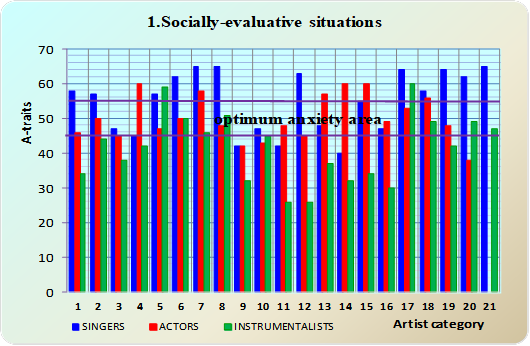
Figure
These anxiety scores are possible to reflect exacerbated self-confidence, the effects of emotions on the somatic, physiological and cognitive levels being moderate or even reduced. This might also be interpreted as an increase in their ability to focus on the artistic roles to the detriment of identifying potential dangers.
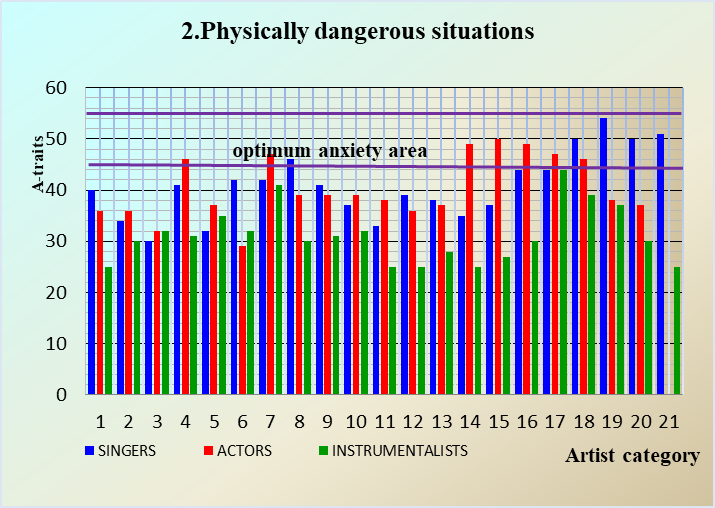
Figure
In the category of instrumentalists, most of the scores are outside the optimal range. Thus, 5 subjects are slightly below average, 5 are much below average, and 2 are very much below average.
The recorded anxiety scores indicate increased emotionality, somatic manifestations, worry and concern in the case of high and very high scores, with a possible impact on professional performance, while the scores that are much and very much below average might be associated with the stimulation of physiological, somatic and cognitive spheres. This is possible to reflect self-confidence or, on the contrary, a lack of awareness of unexpected situations. Since these situations are unpredicted, they are susceptible to generate a numbness state, a lack of reaction similar to the start-fear state in performance athletes. In artists, the so-called stage fright or mental block arises as a negative form of emotionality.
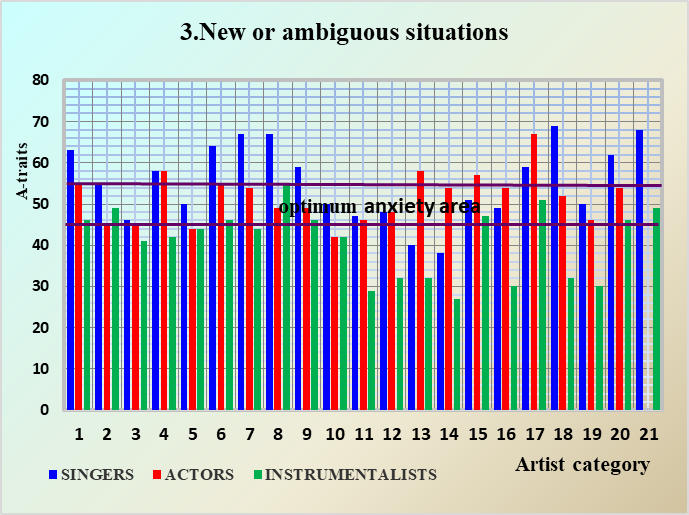
Figure
Singers and actors are possible to be more stressed because, in the systematic rehearsal period, they receive explanations and guidance from directors. Being under preparation, the role is not clearly shaped from the very beginning, the director proposing new and new rehearsals until the required level is reached. It is then that the anxiety state arises, with a possible decrease in self-confidence and concern due to directorial exigencies. If the role is appropriately learned, the anxiety state diminishes. This is also revealed by the scores achieved by artists in socially-evaluative situations, which are comparable to their public performance during seasons, and the scores recorded in new or ambiguous situations, when they take part in awards ceremonies or theatrical tours.
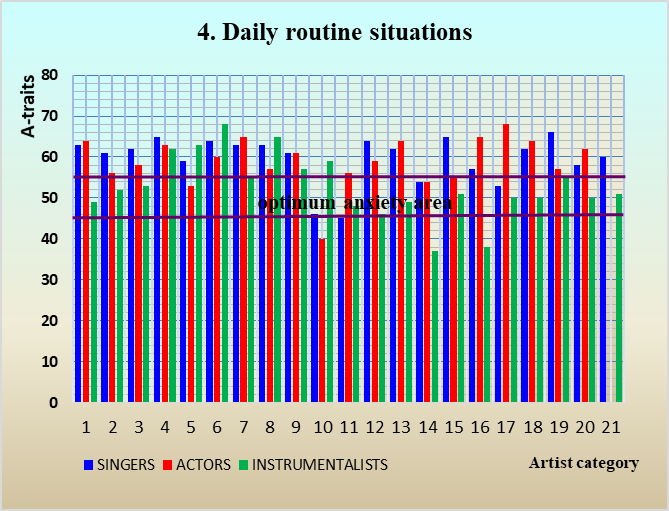
Figure
The average scores, taking into account the recorded T-ratio ranges, indicate that actors and singers fall within the optimal anxiety range in socially-evaluative situations. Professional specificity consists in their stage performance in front of an audience, the presence of television cameras or their participation in auditions to get contracts.
Actors remain within the optimal anxiety range also in the case of new or ambiguous situations, where singers record scores slightly above this range.
On average, instrumentalists have scores slightly below the optimal anxiety range for socially-evaluative situations and new or ambiguous situations, and much below this range in physically dangerous situations. A possible interpretation would be that instrumentalists work in a band, an orchestra, and master the instruments very well, as a result of years of practice. This might be due to their experience gained in the art of playing an instrument during childhood, which is comparable to the training sessions of performance athletes.
In daily routine situations, both singers and actors have scores slightly above the optimal anxiety range, but instrumentalists are within this optimal range. In other words, singers and actors experience a slightly higher level of anxiety in daily activities, as compared to instrumentalists. They generally feel more tension probably due to the specificity of their work. Performance depends only on what they do starting at zero time (t0), because they do not feel that their responsibility is shared, as in the case of instrumentalists, whose state has the potential to reduce anxiety.
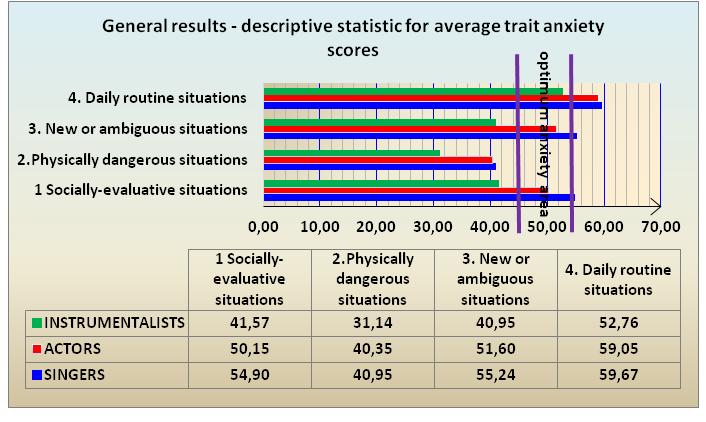
Conclusion
The results of the study show progress in the manifestation of some personality traits in the investigated subjects. Considering the requirements of human resources psychology, we believe that the modelling of personality, and implicitly anxiety, should be adapted to the requirements of each profession and related to the necessary competencies (Craiovan, 2006). The formation of particular artistic and speciality competencies should be achieved in the context of personality traits adapted to the field (Oprea, 2008).
Diagnosing the level of anxiety can lead to achieve a profile of the respondents, providing us with information for structuring adapted motor programmes.
Physical training can bring motor improvements, with a positive impact on body integrity, by developing the ability to give favourable motor responses to situations arising in professional practice. In this context, we propose motor programmes that allow the development of specific psychomotor abilities and also improvements in the artistic profession. We want these programmes to become bearer instruments which are beneficial to routine artistic training and while performing on stage.
Practicing different physical exercises and learning techniques based on breathing, relaxation, visualisation, yoga, stretching etc. are means able to get the body out of possible mental blocks or apathy states (Predoiu, 2016).
The conclusion of our research is that professionals working in the artistic environment have levels of anxiety that differ according to their profession. Thus, actors and singers are, on average, within the optimal anxiety range for “socially-evaluative situations” and “new or ambiguous situations”, while instrumentalists have, on average, scores slightly below the optimal anxiety range. Regarding the evaluation of anxiety in “physically dangerous situations”, all three categories of professionals have scores much below average (instrumentalists) and slightly below average (actors and singers), compared to the optimal anxiety range. For “daily routine situations”, instrumentalists fall within the optimal anxiety range, while actors and singers have anxiety scores slightly above average.
Applying the EMAS-T test has contributed to both revealing issues related to emotionality as a trait and understanding the pattern of anxious reactions that professionals working in the cultural and artistic environment may have in different situations. Based on the above and the results validated by statistical calculations, we believe that our research has achieved its purpose.
Acknowledgment
Authors’ contributions
All authors contributed equally to this article and should be considered as main authors.
References
- Cehov, M. (1953/2014). Către actori despre tehnica artei dramatice. Caietele Bibliotecii UNATC, 16(2). Retrieved from http://unatc.ro/cercetare/documente/caieteleBiblioteciiUNATC16.pdf
- Craiovan, M. P. (2006). Introducere în psihologia resurselor umane. București: Editura Universitară.
- Drăghici, A. (2013). Anxietatea – cadru general de analiză a fenomenului patologic şi de dispoziţie emoţională normală. Sibiu: Universitatea “Lucian Blaga”. Retrieved from http://www.amtsibiu.ro/Arhiva/2013/Nr1-ro/Draghici_pdf.pdf
- Gherghișan, A., & Neesham, Ch. (2015). Față în față cu Jocurile Olimpice. București: Institutul Național de Cercetare pentru Sport.
- Krane, V. (1993). A practical application of the anxiety-athletic performance relationship: The zone of optimal functioning hypothesis. The Sport Psychologist, 7(2), 113-126.
- Macovei, S., Toniţa, F., & Lambu, E. (2011). Étude sur la manifestation de l’anxiété précompétitive chez les sportifs de haute performance en karaté do. Discobolul, VII, 3(25), 65-70.
- Matthews, G., Deary, J., & Whiteman, M. (2012). Psihologia personalității. Trăsături, cauze, consecințe (Ed. a II-a revăzută și adăugită). Iași: Polirom.
- Mitrache, G., & Tüdös, S. (2011). Mijloace psihoterapeutice. București: Discobolul.
- Mitrache, G., Tüdös, S., & Predoiu, R. (2015). Psihologia sportului – Curs în tehnologia IFR. București: Discobolul.
- Mitrache, G., Predoiu, R., Coliță, E., & Coliță, D. (2013). A-state, A-trait and the performance of 14-15 years old football players. Procedia – Social and Behavioral Sciences, 127, 321-325. doi: 10.1016/j.sbspro.2014.03.264
- Oprea, C. (2008). Competențele profesorului în învățarea interactiv-creativă. In S. Cristea (Coord.), Curriculum pedagogic (Ed. a II-a) (Vol. 1, pp. 405-419). București: Editura Didactică și Pedagogică.
- Predoiu, R. (2016). Psihologia sportului. Maximizarea performanței sportive. Iași: Polirom.
Copyright information

This work is licensed under a Creative Commons Attribution-NonCommercial-NoDerivatives 4.0 International License.
About this article
Publication Date
16 February 2019
Article Doi
eBook ISBN
978-1-80296-054-9
Publisher
Future Academy
Volume
55
Print ISBN (optional)
-
Edition Number
1st Edition
Pages
1-752
Subjects
Sports, sport science, physical education
Cite this article as:
Vlăduțu, G. (., Predoiu, R., Macovei, S., & Zahiu, M. (2019). Anxiety In Professionals Working In The Cultural And Artistic Environment. In V. Grigore, M. Stănescu, M. Stoicescu, & L. Popescu (Eds.), Education and Sports Science in the 21st Century, vol 55. European Proceedings of Social and Behavioural Sciences (pp. 316-325). Future Academy. https://doi.org/10.15405/epsbs.2019.02.40
